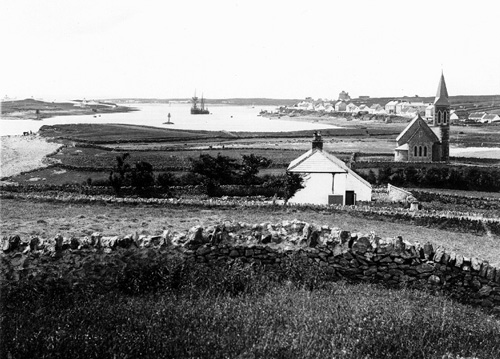Our Church of Ireland
An extract from Woodmartin's History of Sligo
The parochial district of Rosses Point owes it's formation mainly to the exertions of
the late Mrs. E. J. Cooper of Markree Castle, who noticed the long-felt want of a place of worship for
the many Protestant visitors to the seaside during the summer months. Originally The
Rosses having formed part of the very extensive parish of Drumcliff, depended for the
ministrations of religion on the services of the rector and his curate, by whom (during
the bathing season) divine worship was conducted on Sunday afternoon in a room of some
farmhouse, lent by the owner for the purpose.
Castle, who noticed the long-felt want of a place of worship for
the many Protestant visitors to the seaside during the summer months. Originally The
Rosses having formed part of the very extensive parish of Drumcliff, depended for the
ministrations of religion on the services of the rector and his curate, by whom (during
the bathing season) divine worship was conducted on Sunday afternoon in a room of some
farmhouse, lent by the owner for the purpose.
At Elsinore, which was then the property of the Cooper family, the visitors to the
seaside were invited to attend, and occasionally clergymen of the Diocese, who chanced to
be temporarily lodging at the Point, held services and ministered wherever congregations
could be brought together.
But the irregularity and inconvenience of these arrangements were keenly felt, when, as
happened year by year, the number of Protestant visitors increased.
Therefore, with the consent of the Rev. Thomas Crawford, then Rector of Drumcliff, it
was resolved, that a Parochial district should be severed from the mother parish, under
what was known as the Peel Act of Parliament, and a church built in which an incumbent
should conduct the services of the United Church of England and Ireland, and have
spiritual charge of the new parish - the appointment to be placed in the hands of five
trustees.
Appeals for aid towards carrying out the desired object were accordingly made, and a
sufficient amount was raised for the erection of the church now standing at the entrance
to the village of Rosses Point, and also for endowment of the incumbency, whenever a
nomination thereto could be made. A sum of over £500 was expended in the building for
fittings of the church and £1,395 was provided for endowment. The first stone was laid on
the 14th August 1854 - the architect was William Dean Butler, and the builder, Henry
Caldwell.
For some years after 1858, when the building was opened for Divine Service during the
summer months, the clergy of Drumcliff officiated there on Sunday afternoons and conducted
a school for the children of the coastguards and other residents of the district.
In 1867, the then rector, feeling himself unable, through infirmity of age, to keep up
the summer service at the Rosses, secured for a short period, the aid of the Rev.
Frederick Flood, A.B., Vicar of Kilmood, in the diocese of Down, who eventually accepted
the incumbency of the church, and in August, 1869, he entered on the charge of the parish,
in which he still continues to serve.

 Castle, who noticed the long-felt want of a place of worship for
the many Protestant visitors to the seaside during the summer months. Originally The
Rosses having formed part of the very extensive parish of Drumcliff, depended for the
ministrations of religion on the services of the rector and his curate, by whom (during
the bathing season) divine worship was conducted on Sunday afternoon in a room of some
farmhouse, lent by the owner for the purpose.
Castle, who noticed the long-felt want of a place of worship for
the many Protestant visitors to the seaside during the summer months. Originally The
Rosses having formed part of the very extensive parish of Drumcliff, depended for the
ministrations of religion on the services of the rector and his curate, by whom (during
the bathing season) divine worship was conducted on Sunday afternoon in a room of some
farmhouse, lent by the owner for the purpose.